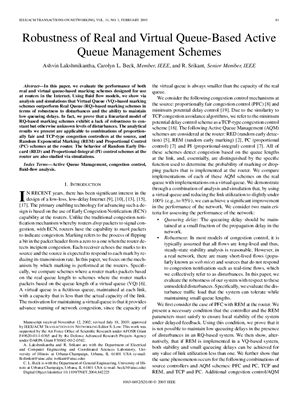IEEE/ACM TRANSACTIONS ON NETWORKING, VOL. 13, NO. 1, FEBRUARY
2005.
In this paper the performance of both real and virtual queue-based marking schemes designed for use at routers in the Inteet are evaluated . Using ?uid ?ow models via analysis and simulations show that Virtual Queue (VQ)-based marking schemes outperform Real Queue (RQ)-based marking schemes in terms of robustness to disturbances and the ability to maintain low queueing delays. In fact, it is proved that a linearized model of RQ-based marking schemes exhibit a lack of robustness to constant but otherwise unknown levels of disturbances. The analytical results are applicable to combinations of proportionally fair and TCP-type congestion controllers at the source, and Random Exponential Marking (REM) and Proportional Control (PC) schemes at the router. The behavior of Random Early Discard (RED) and Proportional-Integral (PI) control schemes at the router are also studied via simulations
Active Queue Management, congestion control, fluid-flow analysis.
In this paper the performance of both real and virtual queue-based marking schemes designed for use at routers in the Inteet are evaluated . Using ?uid ?ow models via analysis and simulations show that Virtual Queue (VQ)-based marking schemes outperform Real Queue (RQ)-based marking schemes in terms of robustness to disturbances and the ability to maintain low queueing delays. In fact, it is proved that a linearized model of RQ-based marking schemes exhibit a lack of robustness to constant but otherwise unknown levels of disturbances. The analytical results are applicable to combinations of proportionally fair and TCP-type congestion controllers at the source, and Random Exponential Marking (REM) and Proportional Control (PC) schemes at the router. The behavior of Random Early Discard (RED) and Proportional-Integral (PI) control schemes at the router are also studied via simulations
Active Queue Management, congestion control, fluid-flow analysis.

